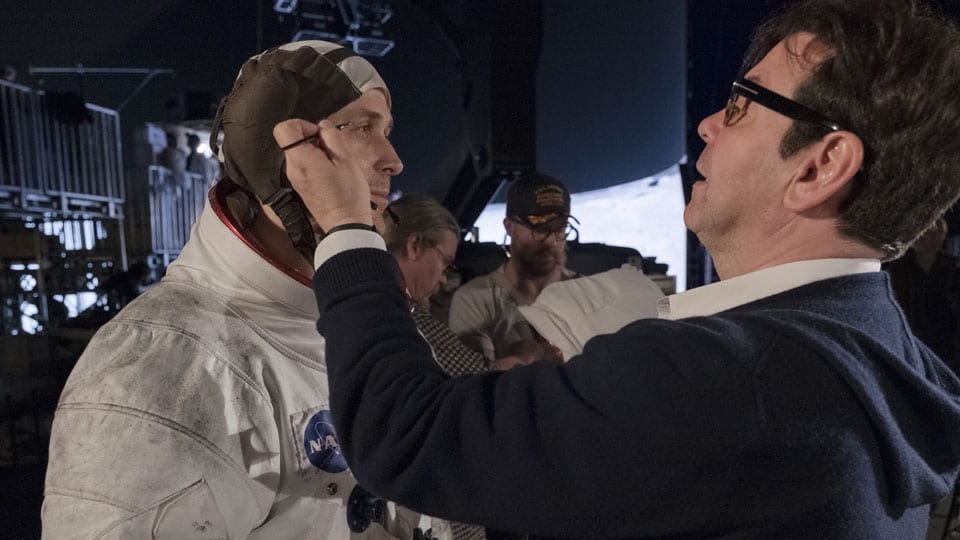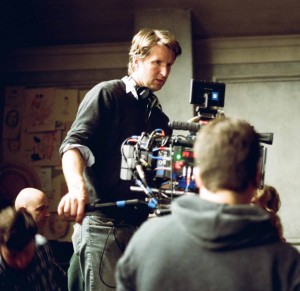
Director Tom Hooper credits his casting director with bringing the screenplay to his attention. “As we are talking about below the line crafts, it is appropriate that this film only came into being because of Nina Gold, my wonderful casting director on pretty much everything I’ve done since I was 21. I was complaining to her about where the great scripts are. She said ‘I know of one great unmade script. It’s called The Danish Girl.’ I read it and fell in love with this amazing love story.”
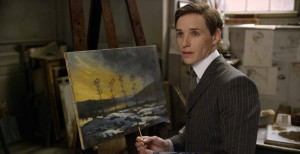
In establishing the look of the film, Stewart suggested Hooper look at the paintings of Danish artist Vilhelm Hammershøi (1864-1916) – prominent earlier than Gerda and Einar/Lili – who worked mainly in his native city of Copenhagen, painting portraits, architecture and interiors, but also painted landscapes of the surrounding countryside. The production designer proposed they build a set inspired by the Hammershøi paintings as the Danish apartment for Lili and Gerda to live in.
“Hammershøi expresses something I found to be very Danish when I went to Copenhagen. He mainly painted figures in his own apartment, which is that wonderful, austere, blue-gray color palette. There’s a sense of loneliness and a slight alienation in his paintings. If you look online at some of his paintings there are certain shots that are literally replicas of the Hammershøi work,” said Hooper. “I thought that was a very clever idea of Eve’s because I wanted to find a visual way of suggesting that Lili living as Einar, although happy, there was something uncomfortable. He was slightly trapped. The austerity of that Danish look, a sense that the color palette is limited, that you’re living in a tight, claustrophobic space of color, is a way of talking about what it was like to be constricted as a woman living as a man.”
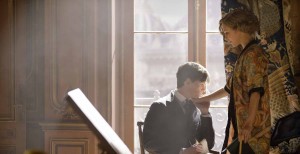 The soft light in the paintings inspired Cohen. The filmmakers discussed what makes Scandinavian northern light special, in particular the light of the long summer days and magic hours. They took into account that art studios always have a big window to the north that always conveys a soft light and this quality of light might help bring Lili to life.
The soft light in the paintings inspired Cohen. The filmmakers discussed what makes Scandinavian northern light special, in particular the light of the long summer days and magic hours. They took into account that art studios always have a big window to the north that always conveys a soft light and this quality of light might help bring Lili to life.
“Danny and I started shooting tests with Eddie a long time before production, playing around with the way to light Lili and the way to photograph Lili,” explained Hooper. “We made discoveries, like when Eddie is Lili, to put the camera slightly above her eye line helped bring Lili out partly because if you’re shooting a scene with a woman and a man, the man is often taller, and the woman is often shorter, so you are often slightly looking down on the woman and up on the man. I thought if we looked slightly down on Eddie as Lili that would help us shift our perspective.”
The filmmakers also shot very shallow depth of field on Lili in order to bring out the femininity on camera, much as Gerda was trying to bring out the femininity when she painted her husband. Using the Red Epic Dragon, they tested every lens and decided to shoot wide open on Zeiss Master Primes. The team, including Jan Sewell, the makeup supervisor, put in a lot of work studying femininity and how to best achieve it on screen.
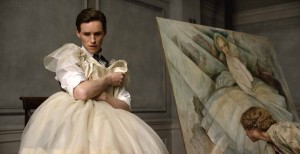 “We played games in the film that you’ll notice if you watch it again,” Hooper added. “When Lili is being successfully Lili, passing or blending successfully, we the filmmakers give her support in that success. When it starts to go wrong, we pull out some of the supports. We pull out some of the softer lighting and the lens choices change and the heights change. We’re sort of colluding with Lili, or not, depending on her sense of whether she is successful.”
“We played games in the film that you’ll notice if you watch it again,” Hooper added. “When Lili is being successfully Lili, passing or blending successfully, we the filmmakers give her support in that success. When it starts to go wrong, we pull out some of the supports. We pull out some of the softer lighting and the lens choices change and the heights change. We’re sort of colluding with Lili, or not, depending on her sense of whether she is successful.”
The idea for how to approach the French locations came from Lana Wachowski (The Matrix). She knew a lot about Lili and Einar and suggested the Art Nouveau period as a backdrop for Lili’s emergence because that artistic movement was about the “rejection of the masculine, the rectilinear, the straight line, the embracing of the feminine in design, of the curved line, of the explosion of color, of floral prints.” The team loved the idea of using this revolution of 20th century art as a visual metaphor for Lili’s transition from the masculine to the feminine.
Stewart was immediately inspired and proposed the team shoot in Brussels because the city had the best Art Nouveau architecture in Europe. The camera can be set up and a filmic statement is immediately made. Nevertheless, the team was under a lot of pressure to only shoot in Denmark and England. Stewart passionately defended the importance of shooting in Belgium. A lot of the art of production design is in knowing how to spend the allocated monies. Stewart insisted sets could not be built on their budget and the most cost-effective choice was to shoot on location. The country’s fantastic film tax break was a bonus.
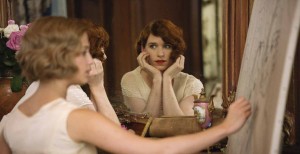 “We both come out of this world of low budget British television. Eve and I met making Elizabeth I for HBO and Channel Four in the U.K. We had $5 million to do a four-hour mini series and we had to recreate Elizabethan England in Lithuania. I kid you not. There is no Tudor England in Lithuania. Everything had to be built. She found a way of building this universe in Lithuania where the craft skills are not the same as London and with this tiny budget. She’s a miracle worker. She’s very skillful at conjuring a lot at a very low budget,” said Hooper.
“We both come out of this world of low budget British television. Eve and I met making Elizabeth I for HBO and Channel Four in the U.K. We had $5 million to do a four-hour mini series and we had to recreate Elizabethan England in Lithuania. I kid you not. There is no Tudor England in Lithuania. Everything had to be built. She found a way of building this universe in Lithuania where the craft skills are not the same as London and with this tiny budget. She’s a miracle worker. She’s very skillful at conjuring a lot at a very low budget,” said Hooper.
The Paris apartment in the film is a set. The production could not afford to build a set or find a Paris spot in London to shoot. Paris was financially out of the question. The production was in a quandary.
“The funniest story about Eve’s ingenuity is she found a Paris apartment in flat pack form on E-bay. It was sitting in someone’s farmyard shed. The paneling had been stored and covered in chicken poop.” Hooper laughed, “If I put in French apartment for sale on E-Bay, I would get nothing. Eve puts a French apartment for sale on E-Bay and she gets a French apartment for no money and we have our set. Serendipity is the key to filmmaking.”
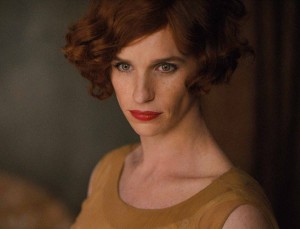 Sewell had helped on the makeup for Les Misérables and worked with Redmayne on the Theory of Everything. Once the film was green lit, Redmayne called Hooper to request that the director consider Sewell as supervisor.
Sewell had helped on the makeup for Les Misérables and worked with Redmayne on the Theory of Everything. Once the film was green lit, Redmayne called Hooper to request that the director consider Sewell as supervisor.
“I have never seen an actor collaborate with a make-up designer like Eddie. It was an extraordinarily intimate and open collaboration between two artists,” remarked Hooper. “The amount of thinking and care that went into bringing Lili to life from Jan’s side… it is one of the great moments of her craft.”
“The film was a reunion of people, but it also really marks quite long collaborations with my team,” noted Hooper. “My editor, Melanie Oliver, this is the sixth thing she’s edited for me. She did the whole of John Adams [HBO mini-series] by herself, all nine hours, which is kind of an extraordinary feat of stamina. I remember presenting her a million feet of film on John Adams.”
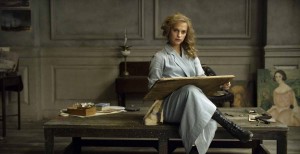 Post on the film was 22 weeks. According to Hooper, Oliver is like a co-director, “She’s my Thelma Schoonmaker. She’s that person.” Hooper trusts her instincts not only in how to put a scene together, but also her choice of performance.
Post on the film was 22 weeks. According to Hooper, Oliver is like a co-director, “She’s my Thelma Schoonmaker. She’s that person.” Hooper trusts her instincts not only in how to put a scene together, but also her choice of performance.
“The internal work of picking the right take, she is brilliant at,” commented Hooper. “That’s rare to be so on it.”
In one area, towards the end of the film when Lili’s gone back for the second operation, there was an evolution in the cutting. Initially Redmayne’s performances were very brave and jokingly light hearted, but Hooper had the actor do a take where the risk was more apparent, where fear could be felt under the surface. Although the lighter performance was originally in the edit, ultimately the director felt the audience needed to feel the risk that the character was facing.
In general Oliver is so thorough in her assemblies that the director admits he rarely “unpicks the work.” The script read fast, but played slower due to all the emotion so the original cut ran long and had to be trimmed to two hours. Most of the time editing is about structure, getting the running time down by deciding what goes and what stays, while pacing the scenes correctly as the edit is shaped. Hooper and Oliver carefully avoided any repetition and cut scenes that might be repeating emotional beats.
Alexandre Desplat was another key part of the team. Hooper invited the composer in to watch an early cut. The first thing he said to the director was that he wanted to create a sense of strength in the music that would reflect the strength of Lili. That Lili must emerge. Lili must come into existence.
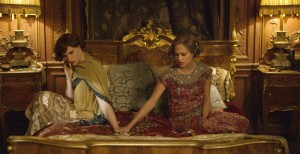 “I think that was a good insight,” stated Hooper. “The interesting thing about music on a film is that it is the only thing that is like a narrator. The characters aren’t hearing the music. There is no music in the scene, so it’s the one thing that we the filmmaker put on to say to the audience, ‘This is what the scene means.’ With this topic, there is such responsibility.”
“I think that was a good insight,” stated Hooper. “The interesting thing about music on a film is that it is the only thing that is like a narrator. The characters aren’t hearing the music. There is no music in the scene, so it’s the one thing that we the filmmaker put on to say to the audience, ‘This is what the scene means.’ With this topic, there is such responsibility.”
Desplat first composed a score with a dark and strange tone for the scene where Lili puts on the stockings, but the music implied that coming in touch with your true identity is somehow dark. Then he scored the joy of it, but that seemed patronizing, implying that becoming a woman is this pretty beautiful thing with none of the anxiety.
“In the end we both realized that the key was the score needed to combine pain and joy, anxiety and hope,” said Hooper. “In the moment when she is holding the dress against herself, the music needs to talk about this door opening to a happiness that she never knew existed, but at the same time, to get through that door is going to cause her untold anxiety because she is going through it at a time when no one is going to accept what she says about herself. When we came up with the idea that the music is a negotiation between these twin poles, then he was off and running.”
“I feel very lucky about my team. I feel like every time we go to work, it’s like continuing a conversation that we left off last time.” Hooper concluded, “I love talking about my team. They’re so great!”





